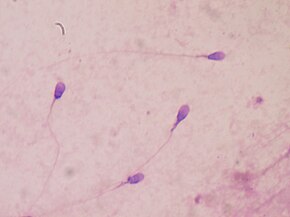
But another study was also just published that showed (in mice) that effects of chronic exposure to endocrine disrupting chemicals are amplified over 3 generations - and each generation has even lower sperm counts, sperm concentration, and reproductive abnormalities. So each generation gets progressively worse with continued exposure.
As the researchers state: "Our findings suggest that neonatal estrogenic exposure can affect both the reproductive tract and sperm production in exposed males, and exposure effects are exacerbated by exposure spanning multiple generations. Because estrogenic chemicals have become both increasingly common and ubiquitous environmental contaminants in developed countries, the implications for humans are serious. Indeed, it is possible effects are already apparent, with population-based studies from the U.S., Europe, Japan, and China reporting reductions in sperm counts/quality and male fertility within a span of several decades." Yikes...
The World Health Organization (WHO) considers an impairment in ability to fertilize an egg at 40 million sperm per milliliter or below, and the level where WHO considers fertilization unlikely is 15 million sperm per milliliter. This is why the sperm count study discussed in the last post is so frightening: North American, Canadian, Australian, and New Zealand men whose partners are not yet pregnant nor do they have children (i.e., they are not confirmed fertile men) have experienced a drop in average sperm count of about 50 percent over four decades, to 47 million sperm per milliliter. Niels Skakkebæk, a Danish pediatrician and researcher working on this topic said: "Here in Denmark, there is an epidemic of infertility."and "Most worryingly [in Denmark] is that semen quality is in general so poor that an average young Danish man has much fewer sperm than men had a couple of generations ago, and more than 90 percent of their sperm are abnormal." Uh-oh...What will it take for governments to address this serious issue?
In the meantime, see the last post for some tips on how to reduce your own exposure to endocrine disrupting chemicals. Just note that you can reduce exposure, but you can't totally eliminate exposure. Excerpts from Environmental Health News:
Science: Are we in a male fertility death spiral?
Margaret Atwood's 1985 book, The Handmaid's Tale, played out in a world with declining human births because pollution and sexually transmitted disease were causing sterility. Does fiction anticipate reality? Two new research papers add scientific weight to the possibility that pollution, especially endocrine disrupting chemicals (EDCs), are undermining male fertility.
The first, published Tuesday, is the strongest confirmation yet obtained that human sperm concentration and count are in a long-term decline: more than 50 percent from 1973 to 2013, with no sign that the decline is slowing. "The study is a wakeup that we are in a death spiral of infertility in men," said Frederick vom Saal, Curators’ Distinguished Professor Emeritus of Biological Sciences at the University of Missouri and an expert on endocrine disruption who was not part of either study.
The second study, published last week by different authors, offers a possible explanation. It found that early life exposure of male mouse pups to a model environmental estrogen, ethinyl estradiol, causes mistakes in development in the reproductive tract that will lead to lower sperm counts. According to vom Saal, the second study "provides a mechanistic explanation for a progressive decrease in sperm count over generations." What makes this study unique is that it examined what happened when three successive generations of males were exposed—instead of just looking only at the first. Hunt, in an email, said "we asked a simple question with real-world relevance that had simply never been addressed."
In the real world, since World War II, successive generations of people have been exposed to a growing number and quantity of environmental estrogens—chemicals that behave like the human hormone estrogen. Thousands of papers published in the scientific literature (reviewed here) tie these to a wide array of adverse consequences, including infertility and sperm count decline. This phenomenon—exposure of multiple generations of mammals to endocrine disrupting compounds—had never been studied experimentally, even though that's how humans have experienced EDC exposures for at least the last 70 years. That's almost three generations of human males. Men moving into the age of fatherhood are ground zero for this serial exposure.
So Horan, Hunt and their colleagues at WSU set out to mimic, for the first time, this real-world reality. They discovered that the effects are amplified in successive generations. They observed adverse effects starting in the first generation of mouse lineages where each generation was exposed for a brief period shortly after birth. The impacts worsened in the second generation compared to the first, and by the third generation the scientists were finding animals that could not produce sperm at all. This latter condition was not seen in the first two generations exposed. Details of the experimental results actually suggested that multiple generations of exposure may have increased male sensitivity to the chemical. [Original study.]
